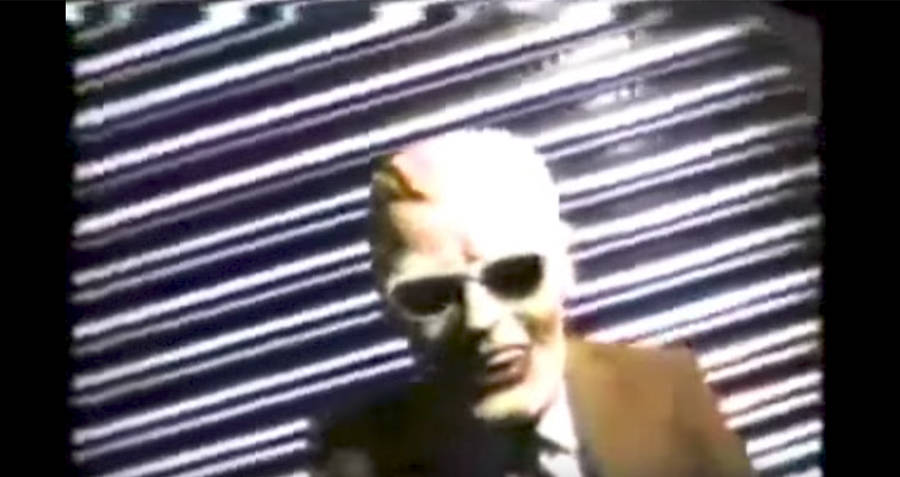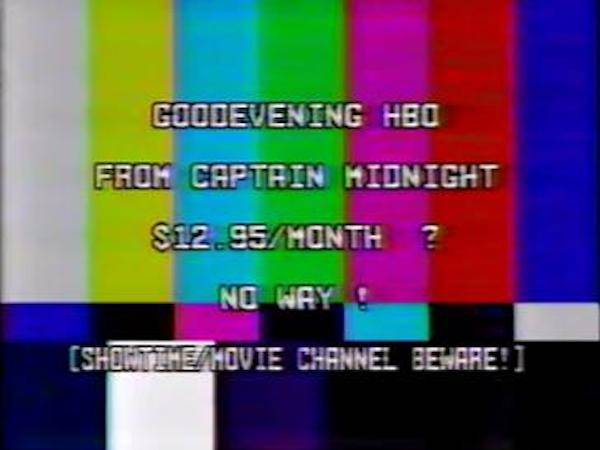During the Max Headroom hack of 1987, Chicago television stations were overtaken by a masked man who continues to baffle authorities to this day.
The First Max Headroom Hack
The Max Headroom incident came entirely out of the blue. On November 22, 1987, Chicago sportscaster Dan Roan was covering the highlights of the Bears’ recent victory over the Detroit Lions.
It was his usual spot during Channel 9’s “Nine O’Clock News” segment, one he had been doing for years, always the same. Tonight, however, it would be different.
At 9:14, Dan Roan disappeared from the screen. In fact, everything disappeared from the screen as it flickered into darkness. Then, 15 seconds later, a new figure appeared.
Dressed in a rubber mask and wearing sunglasses, the mysterious intruder looked like artificial intelligence television character Max Headroom. Even the gray background behind the figure was reminiscent of the simulated background that appeared behind Headroom.
There was hardly any sound, but the image was still frightening. The figure bobbed around in front of the spinning background as a buzzing noise played.
After 30 seconds, signal engineers at WGN, who broadcasted Channel 9, switched the frequency of the studio link to another transmitter, bringing Dan Roan back to audiences’ screens.
“Well, if you’re wondering what’s happened,” he said, clearly as confused as the viewers, “…ha-ha…so am I.”
After the brief interruption, Roan continued his previously scheduled broadcast.
Studio engineers assumed that the hijack was an inside job and immediately began searching the building for the masked intruder. However, their search was unsuccessful, as the broadcast turned out to be a pre-recording from a third party at a separate location.
And there was another one on the way.
The Hacker Returns For A Second Show

YouTubeThe masked figure from the Max Headroom incident.
Two hours after the first episode, the Max Headroom impersonator was back — this time on Channel 11.
At 11:15 PM, the PBS affiliate WWTW was airing a Doctor Who episode titled “The Horror of Fang Rock.”
Then, as suddenly as before, the video cut out.
Scan lines, like those at the beginning of a VHS recording, appeared, followed by the familiar masked figure. The figure bobbed in front of the rotating background as before, the same mask covering his face. However, unlike the 9:15 recording, this one had audio.
“That does it,” the figure said, its voice distorted. “He’s a fricken nerd.”
The figure then laughed. He mentioned Chuck Swirsky, a WGN pundit, claiming to be better than him.
Then he held up a can of Pepsi while reciting the Coca-Cola slogan “catch the wave.” Max Headroom was, at the time, being used as a spokesperson for Coke.
After that, the Max Headroom hack got creepier.
The figure flipped off the camera, his middle finger covered in a rubber extension. He sang “your love is fading,” lyrics to (I Know) I’m Losing You by the Temptations. He hummed tunelessly. He muttered phrases from television shows. He screamed nonsense, and then he began to moan.
After a moment, he paused to claim he had “made a giant masterpiece for all the greatest world newspaper nerds,” referencing WGN’s acronym and corporate parent, The Chicago Tribune.
He held up a glove, like the one popularized by Michael Jackson, and exclaimed, “My brother is wearing the other one.” He then pulled it on, saying, “But it’s dirty! It’s like you got bloodstains on it!”
The camera then cut to a shot of a man’s torso and partially exposed buttocks. The Max Headroom mask had been removed and was being held up to the camera. The rubber extension that had covered the figure’s finger was stuffed inside the mouth of the mask.
“They’re coming to get me!” the man screamed suddenly.
“Bend over, bitch,” a female voice responded. The man was then spanked repeatedly with a flyswatter as he screamed.
How They Did It

YoutubeThe removed mask and the woman with the flyswatter from the Max Headroom incident.
The entire Max Headroom hack lasted one minute and 22 seconds before signal transmitters were able to black it out. They discovered that at the time of the incident, there were no engineers on duty at the WTTW transmitter tower. Had there been someone there, the signal could have been stopped. By the time they noticed the error, however, the 90-second transmission was over.
Since there was no one on duty during the transmission, the only copies of the hack came from Doctor Who fans who had been taping the episode on their VCRs. WGN and WTTW covered the incident, broadcasting the video again and again, calling the mastermind behind it a “TV Video Pirate.” Most Chicagoans were amused, some were confused, and some were upset that their television show had been interrupted.
However, while viewers found the Max Headroom hack funny, the government didn’t. The FCC, the agency that regulates the airwaves, dedicated all of their efforts to finding the mysterious masked figure, even offering a reward to anyone with information.
“I would like to inform anybody involved in this kinda thing, that there’s a maximum penalty of $100,000, one year in jail, or both,” Phil Bradford, an FCC spokesman, told a reporter the following day.
“All in all, there are some who may view this as comical,” WTTW spokesman Anders Yocom said. “But it is a very serious matter because illegal interference of a broadcast signal is a violation of federal law. ”
Eventually, the FCC worked out how the hacker had done it. By placing his or her own dish antenna between the transmitter tower, the hacker could have effectively interrupted the original signal. They wouldn’t even have needed expensive equipment, just good timing and positioning.
They were also able to pinpoint a location where the video might have been shot. Based on the background of the videos, agents from the FCC determined it was most likely the roll-down door of a warehouse and tracked it to a district that had warehouses with doors like it.
The Hunt For The Elusive Hacker Behind The Max Headroom Incident Continues

VimeoThe original Max Headroom, a fictional character from a dystopian future.
Though the FCC had found most pieces of the puzzle, the biggest one remained — who was the man behind the mask?
Rumors about the identity of the person responsible for the Max Headroom hack floated around, but they were quickly dismissed — most weren’t even investigated. It seems that whoever did it simply faded into oblivion, satisfied with their work, uneager to continue drawing attention to themselves.
But over the years, a few names have reappeared in forums and reddit threads. Among the most popular contenders is Eric Fournier, the creator of Shaye Saint John, a fictional model who was disfigured in a car accident and recreated her body from mannequin parts.
Fans of Fournier’s Shaye Saint John point to artistic similarities between his bizarre, campy videos and the hacker’s surreal and disconcerting footage, notably the use of masks and unconvincing prosthetics.
Those who knew Fournier best, however, say the link is tenuous. His bandmates are sure Fournier had little to no experience with broadcast communications, and they don’t think he was in Chicago at the time of the hack. They do, however, acknowledge that he would have been amused to be the subject of such rumors.
Sadly, Fournier died in 2010 from internal bleeding — the result of a long battle with alcoholism — and can’t confirm or deny the gossip.
The Legacy Of The Max Headroom Incident
The Max Headroom hack wasn’t the first of its kind — and it wasn’t the last, either.

Wikimedia CommonsThe Captain Midnight HBO broadcast signal interruption of 1986.
One notable forerunner was Captain Midnight, the first hacker to interrupt a broadcast signal with his own personal message. He was mad that HBO had raised its prices, so on Apr. 27, 1986, he interrupted that night’s showing of The Falcon and the Snowman to air his own message.
The Captain Midnight hacker managed to broadcast his colorful message for nearly five minutes before HBO regained control of the signal.
What had been a minor annoyance to viewers posed a major problem for the U.S. government, who were wary of the military implications of amateur satellite hacking. A hack aimed at the navy or the spy satellites that monitored the Soviet Union could prevent the transmission of vital information and compromise state secrets.
The FCC began to investigate immediately — and was inundated with 200 “confessions” from eager hacking enthusiasts hoping to take credit for Captain Midnight’s work.
Unfortunately for the real hacker, only a specific set of antennae was powerful enough to have outmuscled HBO, and the graphics model responsible for rendering the typeface used in his broadcast was rare. The authorities found John R. MacDougall, formerly an operations engineer at the Central Florida Teleport uplink station.
Since hacking was a relatively new crime, his punishment was ultimately minimal: he paid a $5,000 fine, was put on probation, and had his amateur radio license suspended for a year.
But what he did had unsettled more than a few people — so by the time of the Max Headroom hack less than two years later, satellite hijacking was a felony and the stakes were substantially higher.
Today, signal intrusions are more difficult to pull off — but they are occasionally successfully attempted. In 2007, New Jersey viewers of the “Handy Manny” cartoon on Playhouse Disney suddenly found themselves watching porn, and in 2009 a disgruntled Comcast employee managed to interrupt the Super Bowl for Tucson viewers with 37 seconds of porn.
The consequences remain severe and the hackers are usually caught. The Max Headroom hack remains the gold standard: its content was bizarre, its motives were mysterious, and its perpetrator was never caught.
Enjoy this article on the Max Headroom incident? Next, check out the BBC staffer that was caught watching a raunchy video in the background of a news broadcast. Then, read about the shocking live deaths that occurred while cameras were rolling.




